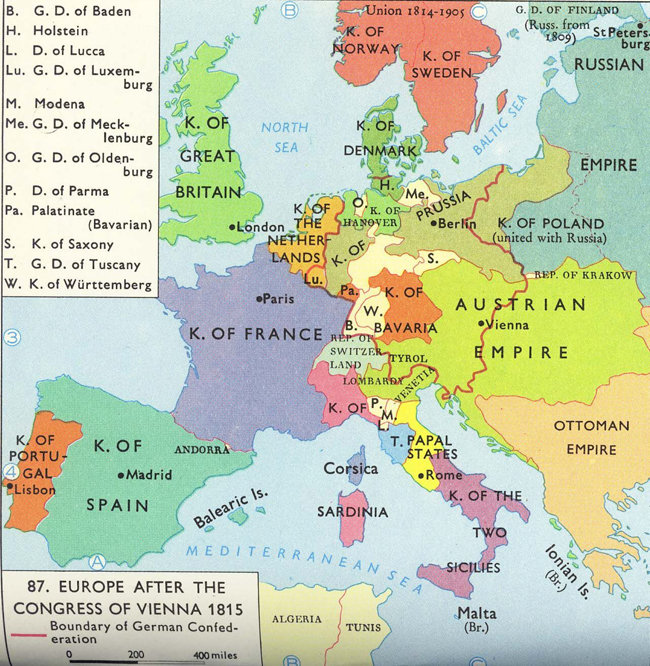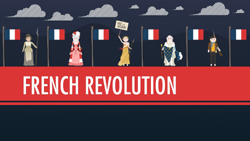-
In 1848, liberals and nationalists rebelled against many
of the conservative governments of Europe.
After the turmoil of the French revolutionary years, European
rulers wanted to return to a conservative order and to keep a balance of
power among nations. Liberals and nationalists, however, struggled
to achieve more liberal governments and new nations. Their struggle
led eventually to the revolutions that swept across much of Europe in 1848.

The Congress of Vienna
-
After Napoleon’s defeat, the victors met and redrew the map
of Europe to create a balance of power and to strengthen conservatism.
Congress of Vienna
A meeting of Great Britain, the German states of Austria
& Prussia, and Russia in September 1814 to arrange a final peace settlement
after the defeat of Napoleon. Their goal was to restore the old order,
as it was before the French Revolution and before Napoleon.
Prince Klemens von Metternich
The haughty Austrian foreign minister who was the most
influential leader of the Congress of Vienna.
Metternich claimed the principle of legitimacy
of the monarchy-- he advocated that the lawful monarchs who ruled before
Napoleon should be restored to their positions of power, as the Bourbon
king Charles X had been brought to the French throne in 1814.
Vienna
The capitol of the Austrian Empire
Balance of Power and Conservatism
The agreements made in the Congress of Vienna were a victory
for the aristocratic rulers who wanted to contain the forces of change
unleashed by the French Revolution.
conservatism
A political philosophy based on order, tradition, and
social stability, favoring obedience to political authority and organized
religion
The meeting of the great powers to discuss their common
interests and to maintain peace that adjourned after Napoleon’s defeat
came to be called the Concert of Europe.
Principles of Intervention
The great powers of Europe decided to adopt a policy
that would ensure the perpetuation of their social order.
Principle of Intervention
The idea that the great powers of Europe have the right
to send armies into countries where there are revolutions, in order to
restore what the conservatives viewed as legitimate governments.
Great Britain refused to accept the principles, arguing
that no one had the right to intervene in the rights of another sovereign
state.
REVIEW & DO
NOW
Answer the following questions in your spiral notebooks: |
| Marie Antoinette, who had been Queen of France before
the Revolution, was not French. What country was she from? |
. |
|
|
Forces of Change
-
Liberals and nationalists opposed the existing conservative
political order.
Liberalism
Liberalism
A political philosophy originally based largely on Enlightenment
principles, holding that people should be as free as possible from government
restraint and that civil liberties—the basic rights of all people—should
be protected.
Civil liberties include equality before the law, freedom
of assembly, freedom of speech, and the freedom of the press.
Liberal believed that civil rights should be guaranteed
by a written document, like the American Bill of Rights.
Bill of Rights
The first ten amendments to the US Constitution, which
guaranteed certain civil rights to its citizens.
Liberals favor a government ruled by a written constitution.
Even in a constitutional monarchy, a king must follow
the laws of the constitution.
Liberals believe written documents would help guarantee
the rights of the people.
Nationalism
Nationalism
The unique cultural identity of a people based on common
languages, religion, and national symbols
Revolutionary Outbursts
Beginning in 1830, the forces of liberalism and nationalism
began to break the conservative domination of Europe.
In France, liberals overthrew the Bourbon monarch Charles
X in 1830 and established a constitutional monarchy with a new king.
Louis Phillipe I, who ruled from 1830 to 1848, would
be the last king of France.
He was supported by wealthy industrialists and bankers--
the new bourgeoisie-- and governed by conservative principles, sponsoring
colonial expansion.
Elsewhere in the same year, 1830, revolutions broke out
in Belgium, Poland, and the Italian states, all inspired by the forces
of nationalism.
Belgium, which had been annexed to the former Dutch Republic
in 1815, rebelled and created an independent state.
Russia crushed Polands attempt to break free of its foreign
rulers and establish a Polish nation-state.
Likewise, Austrian troops marched south and put down rebellions
in the Italian states.
REVIEW & DO
NOW
Answer the following questions in your spiral notebooks: |
| . |
. |
|
|
The Revolutions of 1848
-
Beginning in France in 1848, the spirit of revolution spread
quickly across continental Europe, but in the end, the uprisings were largely
suppressed.
Another French Revolution
Beginning in 1846, severe economic problems brought unimaginable
hardship to the working class, the lower-middle class, and to peasants.
At the same time, the bourgeoise demanded the right to
vote.
King Louis-Phillipe refused to compromise. His monarchy
was overthrown in 1848.
A group of moderate and radical republicans set up a provisional
government.
republicans
those who supported a representative democracy
The provisional government called for a Constituent Assembly
universal male suffrage
The right of all males to vote in elections
The new constitution was ratified on November 4, 1848,
setting up the Second Republic.
Louis-Napoleon
Charles Louis Napoleon Bonaparte, the nephew of Napoleon
Bonaparte was elected first president of the Second Republic of France
in 1848 by a popular vote of all French males.
Trouble in the German States
German Confederation
38 independent German states, including Austria and Prussia,
recognized by the Congress of Vienna in 1815
Revolutions in Central Europe
multinational state
A state in which groups of people of many different nationalities--
ethnicities, languages, and cultural traditions-- live under a single government
In March 1848, demonstrations in the major cities of the
Austrian Empire led to the dismissal of Klemens von Metternich, the Austrian
foreign minister.
Prague
The modern-day capitol of the Czech Republic, where the
Austrian military crushed Czech rebels in June, 1848.
Revolts in the Italian States
REVIEW & DO
NOW
Answer the following questions in your spiral notebooks: |
| . |
. |
|
|
|





